Medicinal Cannabis
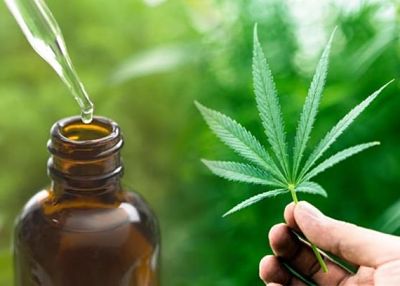
THIS PAGE IS FOR EDUCATIONAL PURPOSES.
An upfront deposit is generally required to make a long appointment. Please do not book on-line.
Please also note our Website Disclaimer Updated 6/8/2023
Overview of medicinal cannabis VIDEO
Overview of treatment VIDEO - MUST WATCH THIS
The advice is general in nature but accurate. UPDATE: oils can simply be taken orally (no need to put under tongue - although a small block of chocolate or other fatty treat will help with absorption.
Video on the nonsense of cannabis-presence driving offences
Here is a link to a video that explores the nonsense of Australia’s cannabis-presence driving offences, and the nonsense of Australia’s police roadside drug testing (RDT) regimes in relation to the enforcement of those offences. This is recommended viewing. Fortunately, laws have changed recently so that magistrates can choose not to suspend licences as long as the driver is NOT IMPAIRED.
You can download a document outlining the legal changes from 1st March from the button below.
Jump to section:
- History
- Indications
- Dependency & Safety
- Entourage effect
- Endocannabinoid system
- Routes of administration
- Oil versus vaping
- Suitability
- Side-effects
- Warning re driving
- Dosing schedule
- Intra-buccal (cheek) spray
- Vaping flower
- Vape cartridges
- Preparing for your first appointment
- Some evidence based articles
History
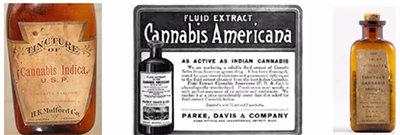
Prior to 1937, cannabis had enjoyed a 5000 year history as a therapeutic agent across many cultures. By the late 19th Century, cannabis-based medications were manufactured by Burroughs-Wellcome & Co. (GSK), Bristol-Myers Squib, Parke-Davis (Pfizer) and Eli Lilly. During hearings on marijuana law in the 1930’s, claims were made about marijuana’s ability to cause men of color to become violent and solicit sex from white women. This imagery became the backdrop for the Marijuana Tax Act of 1937 which effectively banned its use and sales.
Indications
Medicinal cannabis is now legal and available for medicinal use in Australia. Treatment with medicinal cannabis is not about curing the condition being treated. It is about alleviating symptoms, generally with mild side effects, and improving quality of life. There is the potential for one medication to assist with multiple symptoms. The main uses at present are listed below. According to the National Academies of Sciences, there is substantial or moderate evidence for the first 6 in the list, and limited evidence (ongoing trials) for the remainder.
- Chronic pain in adults – in particular neuropathic
- Intractable childhood epilepsy (e.g. Dravet Syndrome)
- Spasticity in multiple sclerosis
- Chemotherapy induced nausea and vomiting
- Sleep problems
- Palliative Care
- Anxiety including PTSD
- Fibromyalgia
- Symptoms of IBS
- Cancer treatment, incl glioma and cancer-associated anorexia
- Achieving abstinence in the use of addictive substances
- Mental health outcomes in individuals with schizophrenia
Dependency & Safety
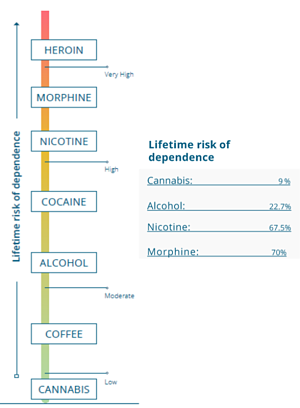
Medicinal cannabis is NOT street cannabis where the composition is unknown, and which may even be contaminated with strongly addictive drugs such as heroin or ICE. This may be why it used to be said that teenagers would "start on weed and end up on heroin."
Cannabis is actually less addictive then caffeine, and much less addictive than opioids.
No-one has ever died from an overdose of medicinal cannabis due to the lack of CB1 receptors in the brainstem cardiorespiratory centres.
Medicinal cannabis is relatively expensive. It is not on the PBS (subsidised by government). You need to budget for up to $200 per month, or more, depending on symptoms and dose needed. Fortunately, prices are dropping and there are offers for pensioners.
Entourage effect
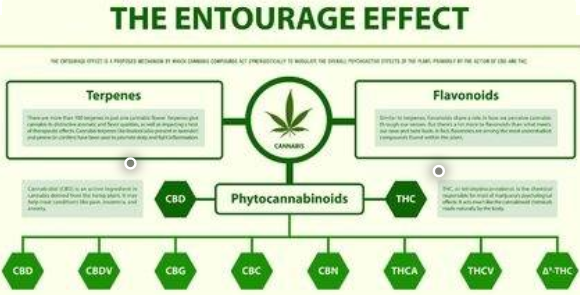
Medicinal cannabis is a combination of two main cannabinoids, the psychoactive THC, and the more immune stimulating CBD, along with hundreds of other compounds (terpenes, which give cannabis its odour, and flavonoids). None of the individual cannabinoids have medicinal broad-spectrum properties. Even a trace of THC makes the CBD more effective. This is why synthetic (lab-derived) cannabinoids such as Nabilone have limited effects, or even cause problems. The benefit arises from the combination of all these compounds, called the entourage effect.
Endocannabinoid system
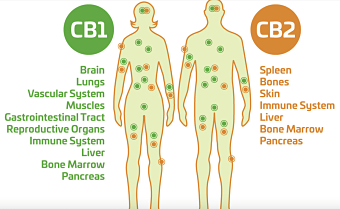
The human body has an in-built (endogenous) cannabinoid system. This means that, like endorphins (natural opioids), the body can produce cannabinoids on its own. This endocannabinoid system comprising of CB1 & CB2 receptors is a signalling system central to homeostasis. Reference: Green Leaf Options Endocannabinoids bind to the receptors to down-regulate neural pain signals and inflammatory responses.
CB1 receptors are mostly found in the brain and CNS and appear to affect cognitive function. CB2 receptors are mostly found in the immune system. THC mainly attaches to CB1 receptors, producing the psychoactive euphoric "high" of cannabis. CBD does not bind strongly to either receptor but interacts with other pathways such as activating serotonin receptors and encourages higher levels of endocannabinoids such as anandamide, our "happy molecule".
THC is more euphoria-producing so very useful for any painful condition, while CBD is more focus-producing so is more useful in ADD, bipolar, PTSD etc.
Routes of administration
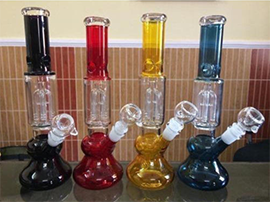
Cannabinoids need to be heated to become active. Traditionally, people smoked cannabis using a pipe or bong. This burns the cannabis. Cannabis smoke delivers 50-70% more carcinogenic hydrocarbons than tobacco smoke and a higher risk of cardiac arrhythmias.
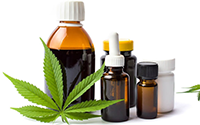
Although there are a variety of oral options, OILS are the most widely used form of medicinal cannabis. Oils can be made with a variety of THC to CBD ratios. Sprays can be more convenient to administer (personal preference and cost). Juicing & teas do not allow adequate decarboxylation of raw plant to activate the cannabis.
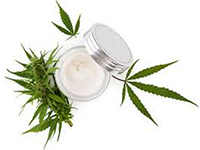
Topicals may help for localised symptoms. Suppositories may be useful for patients with cancer, gastro-intestinal symptoms and in young children or the elderly.
Oil versus vaping (inhaling)
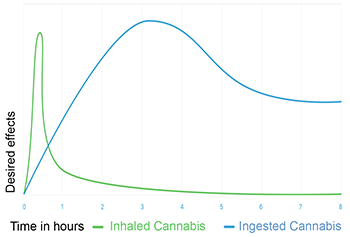
This chart illustrates the different duration of effects between oral and inhaled cannabis. The oral dosing takes longer to start working but lasts much longer, whereas vaping gives an instant effect but wears off quickly. It is thus possible to use a combination of products – oil for the baseline effect and vaped for breakthrough symptoms, especially with respect to pain and corresponds to long and short-acting opiates.
Suitability
Medicinal cannabis may not be suitable for everyone:
- Medicinal cannabis products containing THC are often not appropriate for patients who:
- Have a previous psychotic or concurrent mood or anxiety disorder
- Are pregnant or planning on becoming pregnant or breastfeeding
- Have unstable cardiovascular disease as it may worsen arrythmia
- Cannabis should be avoided in patients with severe cardiovascular, immunological, liver or kidney disease, especially in acute illness
Side-effects
Medicinal cannabis can have side-effects, but these are generally mild. Notably, there were actually no significant differences between the side-effects reported by people receiving medical cannabis and those who received either placebo or nothing at all. The most common side effects of cannabis use include:
- Dry mouth (cottonmouth)
- Red eyes
- Increased appetite (the "munchies")
- Drowsiness
- Dizziness - impaired coordination and reaction time
- Psychological effects (anxiety or paranoia), especially in adolescents
- Decreased short-term memory
- Other physical effects (hypotension - low BP, tachycardia - rapid heart rate)
- Tolerance can develop quickly
- Dependence has been reported, estimated at 1:10 illicit users
- A very small number of patients develop Cannabinoid Hyperemesis Syndrome (CHS), basically an allergy to cannabis.
- High dose THC (and opioids) can sometimes cause gynaecomastia (enlarged breasts) - in men
Cottonmouth, also known as dry mouth, is a common side effect of using cannabis. This occurs because cannabis contains compounds that activate cannabinoid receptors in the salivary glands, leading to decreased saliva production. The reduced saliva can make the mouth feel dry and uncomfortable. It is important to stay hydrated when using cannabis to help alleviate cottonmouth symptoms. Additionally, some individuals find that drinking water or chewing gum can help stimulate saliva production. It is also worth noting that different strains of cannabis can have varying levels of cottonmouth potential, so finding the right strain for you may also help reduce the symptoms.
It's worth noting that the side effects of cannabis use can vary depending on a number of factors, such as the method of consumption, the potency of the product, and the individual's tolerance and personal characteristics. Additionally, long-term use of cannabis can result in other more serious health problems, such as respiratory issues, cognitive impairment, and decreased motivation. It's important to use cannabis responsibly and in consultation with a healthcare professional to minimize potential risks and negative side effects.
Warning re driving
Beware of driving while using medicinal cannabis.
While it is legal to take it for medical purposes, current Victorian law still prohibits driving while there is any detectable THC in your body. For a detailed review, see the video. Of course, regardless of what medication you take, do not drive or operate machinery if you feel impaired.
OIL Dosing schedule
Starting medicinal cannabis oil - start low, go slow, stay low
Take the oil in your mouth using the supplied measuring syringe, and swallow it. A small block of chocolate will help absorption. Start with 0.25ml at night for 3 nights, then increase to twice daily dosing for another 3 days.
Increase the evening dose to 0.4ml for 3 nights, then to 0.4ml twice daily. THEN CONTINUE TO INCREASE until good benefit is (hopefully) felt.
In Summary (Daily Schedule):
| DAY | AM | PM (about 2 hours before bedtime) |
|---|---|---|
| 1 - 3 | 0 | 0.25ml |
| 4 - 6 | 0.25ml | 0.25ml |
| 7 - 9 | 0.25ml | 0.4ml |
| 10 - 12 | 0.4ml | 0.4ml |
Do not expect to have a full effect at this dose, unless you're quite lucky! You now need to decide when in the day you need more (if you do), so you can increase by 0.2ml sometime in the day (morning, middle of the day or night) every 2-3 days.
People typically end up needing somewhere between 1.6ml per day up to 2ml per day in divided doses. At 1.6ml per day, a bottle lasts about a month. Some people need significantly more but this can get expensive.
This can be:
0.4ml in the morning (some people want less) and 0.6-1.2ml at night
0.4-0.5ml 3 times a day
0.6 – 1.0ml twice a day
What works for you is the correct dose. Take it slowly.
Review in a week. After a month, the ratio may need to be tweaked. Build up the cannabis dose first then gradually reduce opioids etc. Don't come off routine medications suddenly, but many patients find they can reduce their use of pregabalin, benzodiazepines and even opioids. Discuss any intended changes with the doctor.
Intra-buccal Spray
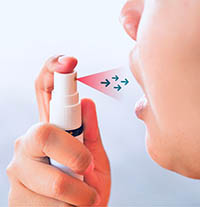
NanoCelle® - THC and CBD NanoCelle® delivery platform is the application of nanotechnology to enhance drug delivery and hence efficacy. NanoCelle® creates nano-sized water-soluble particles of active pharmaceutical ingredients such us THC and CBD that optimises dose requirements. Provides faster and more effective drug absorption. Improves drug bioavailability (amount of drug molecule e.g THC/CBD that reaches systemic circulation). The NanoCelle® delivery route of administration is to spray inside of the cheek allowing direct access to the body’s systemic circulation system via the facial lymphatics.
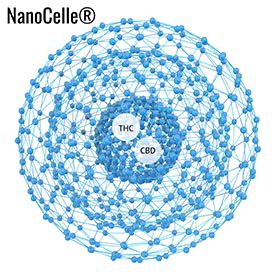
The NanoCelle™ water soluble nanoparticle cannabis‐based medicine clinical studies in cancer bone pain has shown:
Pain reduction by 40% in metastatic cancer patients
Same THC plasma levels (blood stream)
Higher CBD plasma levels (blood stream)
when compared to the only TGA approved cannabis-based medicine.
The level of current evidence on medicinal cannabis efficacy is low-moderated, and further research is needed for the safety of patients.
For patients prescribed this product, here is a video detailing its use.
Vaping dry flower
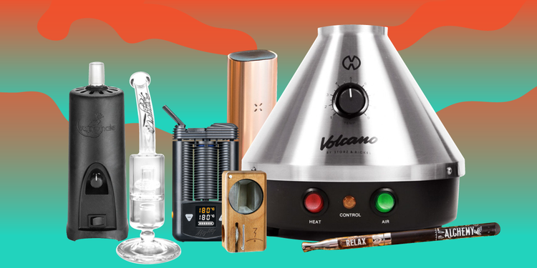
Vaporisation heats the cannabis leaf (don't put oil in the device!) at 160-230°C which is lower than smoking, thus higher bioavailability and fewer harmful effects (takes out the cancer-causing by-products of burning cannabis). Effects are generally felt within minutes and last up to 2-3 hours. The higher the temperature, the stronger the effect. It generally uses plant leaves which are rich in THC, the psychoactive component. Different strains are available.
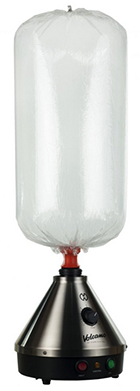
Indica strains are more physically sedating, so better for relaxing or a nightcap before bed.
Sativa strains tend to deliver more energising effects so are better with physical activity, social events and creative projects. Hybrid strains are a combination from the result of crossbreeding cannabis strains. In addition, the terpenes contribute to the entourage effect. You may need to experiment with several products to see which works best for your needs. We can offer you a choice and recommendations.
A selection of vapourisers are available at varying prices. The cheaper portable ones may be more convenient but tend to use up more of the product. Desktop models such as the Volcano may work out cheaper in the long run for regular use. Most vapourisers use 0.25 gram per use.
You can download a Vaporisation Guide which, although provided by one company, is appropriate to most flower products. There are also many sites on the internet with instructions about vaping cannabis. Below are some:
- How to vape weed You will need a dried herb vaporiser such as those by Storz & Bickel made in Germany. The (expensive) Volcano desktop model with digital display is TGA approved and some pharmacies can get them.
- A beginner's guide to dry herb vaporisers From one company - there are others - find a good local vaporiser shop
- How to vape weed From another site. Read the section on vaping dry flower. Don't vape the oil as it has a low burning point and is likely to damage your device.
- Is Vaping Marijuana a Safer Alternative to Smoking? Vaping is safer than smoking but don't vape medicinal cannabis oil
You may also search on the term "SPLOOF" to reduce weed odour. It is beyond the scope of this page.
Vape cartridges
Vape cartridges (mCARTs) are a distillate (liquid concentrate of flower extract) that is an alternative to flower for those patients who don’t like to vapourise flower, is less conspicuous in that it has almost negligent odour when vaped and very little vapour when exhaled. The cartridges contain 500mg of distillate, with each 3 second inhalation utilising 5mg, so a total of about 100 doses. When writing a script, most prescribers write a 3 second inhalation TDS, for example, with most patients actually using PRN (if you're the average patient who uses the cartridge for about 2 weeks, you inhale about 6 times per day). Since most patients find it difficult to time a 3 second inhalation, it is probably easier to take 3 x 1 second inhalations for each dose. The vapouriser used for cartridges is different to the one used for flower. The mCART vaporiser (Jupiter L6 Silo) has an RRP of $50 (at time of writing). If you have your own vape (for nicotine for example), if it has a 510 thread, which most do, then you don’t necessarily need to purchase a new cartridge vapouriser. The onset of action is rapid (5-15 minutes), just like flower, and its duration 2-4 hours. The other thing to keep in mind is that the mg active in the cartridges seems to have more punch, so can’t be directly compared to flower.
Preparing for the first medicinal cannabis appointment
Take a summary of your medical condition, including previous and current treatments. What symptoms do you want to relieve? Ideally write these points down and bring the list with you. You should also download and complete the I'm new to the practice patient form. Finally, it may not be possible to fully fix the problem, and, at present, the cost of the medicinal cannabis can be significant - up to about $200 per month.
Some evidence-based research
You may be interested in some of the following material: